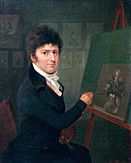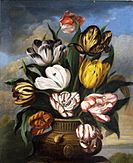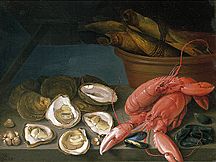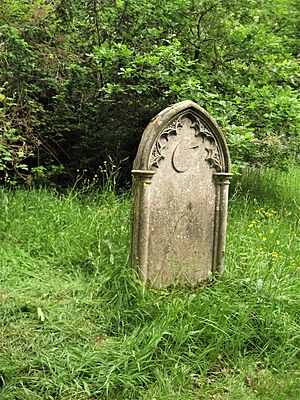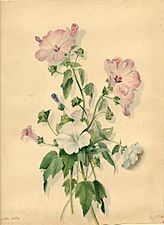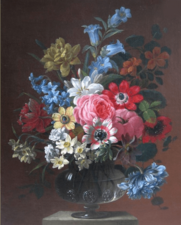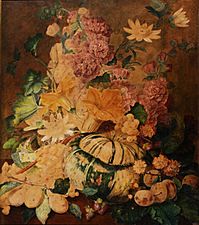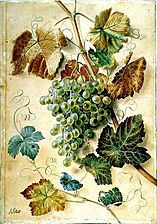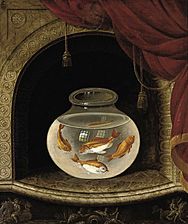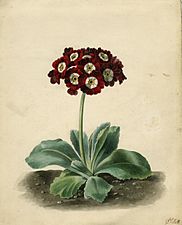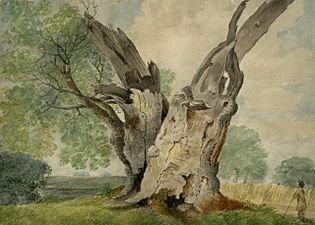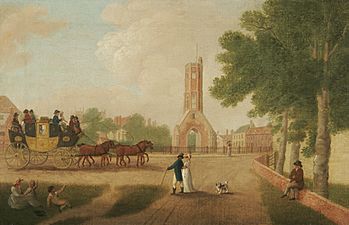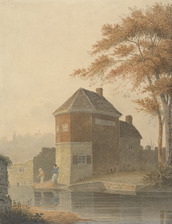James Sillett facts for kids
Quick facts for kids
James Sillett
|
|
|---|---|

Portrait by an unknown artist (undated), Norfolk Museums Collections
|
|
| Born | May 1764 |
| Died | 6 May 1840 (aged 75–76) Norwich
|
| Resting place | Rosary Cemetery, Norwich |
| Nationality | English |
| Education | Norwich Grammar School |
| Alma mater | Royal Academy (disputed) |
| Known for | Still life, topographical drawings of Norwich |
| Movement | Norwich School of painters |
| Spouse(s) | Ann Banyard |
| Elected | Norwich Society of Artists from 1806 (Vice-President 1814, President 1815) |
James Sillett (born before 16 May 1764 – died 6 May 1840) was an English artist. He was known for his beautiful still life paintings and landscapes. A still life painting shows objects that don't move, like fruit or flowers. Landscapes show outdoor scenes.
Sillett was very good at many types of art. He painted still lifes and landscapes, but he also taught drawing. He even painted tiny miniature portraits. His paintings of plants were praised for being very accurate. These plant and still life paintings are thought to be his best work. He often used his accurate plant drawings to illustrate books. His art style was influenced by older artists, which made him a bit different from other artists in Norwich. He showed his paintings at the Royal Academy in London for many years.
James Sillett was born and grew up in Norwich, where he spent most of his life. He first worked as an apprentice (a trainee) for a painter who made heraldic designs (like family crests). Then he moved to London. There, he worked for the Polygraphic Society, making copies of famous paintings. He also helped paint scenery for big theaters like Drury Lane. He said he studied at the Royal Academy, but there is no clear proof of this.
In 1801, he married Ann Banyard. In 1804, they moved back to Norfolk and lived in King's Lynn. While there, Sillett drew pictures for a book called History of Lynn. In 1811, he settled in Norwich with his family. He became a member of the Norwich Society of Artists. He was even the vice-president and then the president of this group. He wrote books about painting flowers and drawing Norwich buildings. These drawings are very important because they show what many old Norwich buildings looked like before they were changed or torn down. James Sillett died in 1840 and was buried in Norwich. His daughter, Emma Sillett, also painted flowers and was a talented artist.
Contents
About the Norwich School of Painters
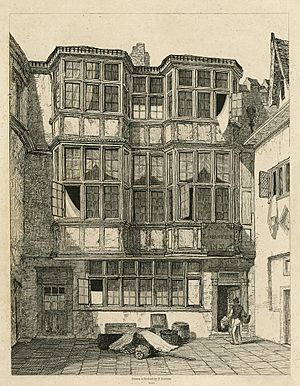
James Sillett was part of a special group called the Norwich School of painters. This group included artists who lived in Norwich or nearby. They often painted scenes of Norwich and the countryside of Norfolk. These artists were also friends and worked together. Norwich was the first city in England, outside of London, to have such a group of local artists. The city had a lively art, music, and theater scene.
The Norwich Society of Artists was a group that many Norwich School painters joined. It started in 1803. Its main goal was for artists to teach each other and their students. They wanted to learn how to improve their painting and sculpture skills. The Society held art exhibitions every year. This helped the artists connect and share their work.
Important artists in the Norwich School were John Crome and John Sell Cotman. Interest in their paintings went down in the 1830s. But the school's fame grew again after a big art show in 1878.
Early Life and Training
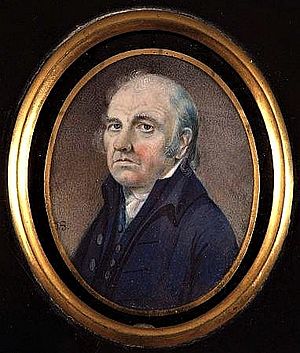
James Sillett was born in Norwich. He was baptized on 16 May 1764 at a church called St Martin at Oak. His last name, Sillett, comes from a very old English word meaning "blessed person."
James's father, also named James Sillett, was born in 1733. His mother was Mary Dobson. They had other children too. We don't know much about James's early life or schooling. We do know he went to Norwich Grammar School.
After school, Sillett became an apprentice to a heraldic painter in Norwich. This is how he started his art career. After his training, he moved to London. He worked as a copyist for the Polygraphic Society. This group made copies of paintings. In 1793, a fire destroyed their building, so Sillett had to find new work.
Sillett once said he studied at the Royal Academy from 1787 to 1790. However, his name is not on any of the Academy's official lists.
Artistic Career and Style
James Sillett was one of the most flexible artists in the Norwich School. He painted many different subjects. His landscapes had a more formal style, which made them different from other artists in Norwich. He also became a good miniaturist, painting tiny portraits. He was very skilled at painting game animals, fruit, and flowers. He often added shadows to his plant paintings to make them look more real.
Out of 342 paintings he showed, only 16 were not still lifes of plants or animals. He admired the art of the 18th century. This influenced his own work. His paintings showed that he had studied artists like the Dutch still life painter Jan van Os. He also made landscape paintings on wood or canvas, and some were later made into prints.
Sillett showed his art at the Royal Academy for over 40 years. While in London, he likely helped paint scenery for big theaters. He worked at Drury Lane and Covent Garden. He moved around a bit, living in London, Norwich, and King's Lynn at different times.
For most of his life, Sillett taught drawing. He advertised himself as an artist and drawing master. In 1804, he moved to King's Lynn to be near his wife's family. He continued to teach drawing there. He also made illustrations for a book about King's Lynn. He drew pictures of church monuments, like the font in St Peter Mancroft church in Norwich.
Later Life and Works
In 1811, Sillett moved back to Norwich for good. He had been a member of the Norwich Society of Artists since 1806. He became the Vice-President in 1814 and the President in 1815. In 1816, he and some other artists left the Society to form a new group. He said that painting flowers and people was more beautiful than painting "pig stys and cart sheds." He showed his work with this new group for three years. Then he returned to the original Norwich Society and exhibited there until 1833.
Even though he was a respected painter, there was competition among drawing teachers. In 1817, Sillett wrote to a local newspaper to make sure people knew he taught more than just "Fruit, Flowers."
In 1826, Sillett published his own book called Grammar to Flower Painting. This book taught people how to draw flowers easily.
In 1828, he published a collection of 59 drawings of Norwich buildings. This book, called Views of the Churches, Chapels and Other Public Edifices in the City of Norwich, used a new printing method called lithography. These drawings are very important for historians today. They show exactly what many important Norwich buildings looked like in the 1820s. Many of these buildings have changed or are gone now.
Sillett might have traveled to Rotterdam and Leiden, as he painted landscapes of these cities. He continued to paint until he died. He once said that life would not be worth living without his pencil. He died on 6 May 1840, in Norwich. He was buried in the Rosary Cemetery. His gravestone has a painter's palette on top. In his will, he left his family £300.
Family Life
In 1801, James Sillett married Ann Banyard. They had five children, but three of them died when they were very young.
Their daughter, Emma, became a well-known painter of flowers. She also painted animals, fruit, and shells. Emma was a very talented artist. She helped her father teach drawing from 1817. Her brother, James Banyard Sillett, born in 1809, did not become an artist. He became a language teacher instead. Emma and James Banyard lived together in Norfolk. Emma died in 1880 at age 77, and her brother died at age 90.
James Sillett's Reputation

Art experts and historians have generally praised James Sillett's work. One historian, William Dickes, called Sillett a careful artist and a skilled drawer. Sillett's still life paintings are considered his best. He painted them using both watercolors and oils.
Some experts say his still life paintings are as good as those by William Jackson Hooker. Hooker was an artist who could make his plant drawings both accurate and beautiful. Sillett's botanical paintings (of plants) were often used in books. They show how skilled he was at making flower petals look delicate and see-through.
Another art historian, Derek Clifford, also praised Sillett's still life works. He noted that only one landscape painting, The Old Oak at Winfarthing (1817), had the same delicate touch. This painting is considered his most famous landscape.
His watercolor paintings are often seen as more appealing than his black-and-white drawings of churches. His landscapes are usually quite small. Sillett's still lifes are praised for being very detailed and stylish. They often show large, carefully drawn flower heads in small vases. For example, his 1803 watercolor Garden Mallows shows petals that are both brightly colored and almost transparent.
According to author Harold Day, Sillett was known for being honest and fair. Day described Sillett's early landscapes as unique and showing a "delightful ability to handle paint." He also praised Sillett's flower paintings, saying they had "good color, carefully drawn and well composed." While his drawings of buildings might not be the most artistic, they are very important for modern historians. This is because they show how many buildings looked in the 1820s before they changed or were torn down.
Today, Sillett's works sell for high prices. For example, his oil painting Auricula Primrose sold for £32,200 in 1996. Another painting, Still-life with Peaches, Apples, Grapes, Plums, Cherries and Gooseberries, sold for £8,625 in 1993. His painting Kings Lynn, Norwich and Lynn Stagecoach sold for £5,200 in 2016.
Galleries
Still lifes and botanical illustrations
Landscapes and buildings
-
Pockthorpe, Norwich (undated), watercolor and graphite over black ink on wove paper, Yale Center for British Art


